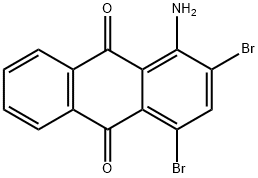Chemical Properties
1-Amino-2,4-dibromoanthraquinone is a red powder or a red solid needles. Odorless
Uses
ADBAQ and other aminoanthraquinones are key intermediates in the production of almost all anthraquinone dyes (HSDB 2009). Anthraquinones, including ADBAQ, are widely used as starting material for the manufacture of vat dyes, which are a class of water-insoluble dyes that can easily be reduced to a water-soluble and usually colorless form. In this form, they are readily impregnated into fibers and textiles. Oxidation then produces an insoluble colored form that is remarkably fast to washing, light, and chemicals. Vat dyes typically are used with cotton, wool, and cellulose acetate (NTP 1996).
Definition
ChEBI: 1-Amino-2,4-dibromoanthraquinone is an anthraquinone.
General Description
Odorless red powder.
Air & Water Reactions
1-Amino-2,4-dibromoanthraquinone is sensitive to long term exposure to air and light . Insoluble in water.
Reactivity Profile
A halogenated amine. Amines are chemical bases. They neutralize acids to form salts plus water. These acid-base reactions are exothermic. The amount of heat that is evolved per mole of amine in a neutralization is largely independent of the strength of the amine as a base. Amines may be incompatible with isocyanates, halogenated organics, peroxides, phenols (acidic), epoxides, anhydrides, and acid halides. Flammable gaseous hydrogen is generated by amines in combination with strong reducing agents, such as hydrides.
Fire Hazard
1-Amino-2,4-dibromoanthraquinone is probably combustible.
Potential Exposure
A halide-and amine-substituted aromatic compound. (halogenated amine). Intermediate in the production of dyes.
Carcinogenicity
1-Amino-2,4-dibromoanthraquinone (ADBAQ) is reasonably anticipated to be a human carcinogen based on sufficient evidence from studies in experimental animals.
Shipping
UN3259 Amines, solid, corrosive, n.o.s, or Polyamines, solid, corrosive, n.o.s., Hazard class: 8; Labels: 8-Corrosive material, Technical Name Required. UN2735 Amines, liquid, corrosive, n.o.s, or Polyamines, liquid, corrosive, n.o.s., Hazard class: 8; Labels: 8-Corrosive material, Technical Name Required.
Incompatibilities
May be combustible. Powder mixture with air may be explosive. Sensitive to air and light exposure, long term. A chemical base: will neutralize acids to form salts plus water with an exothermic reaction. May be incompatible with isocyanates, halogenated organics, peroxides, phenols (acidic), epoxides, anhydrides, and acid halides. Flammable gaseous hydrogen is generated by amines in combination with strong reducing agents such as hydrides, nitrides, alkali metals, and sulfides.
Waste Disposal
Dispose of contents and container to an approved waste disposal plant. Use a licensed professional waste disposal service to dispose of this material. Dissolve or mix the material with a combustible solvent and burn in a chemical incinerator equipped with an afterburner and scrubber. All federal, state, and local environmental regulations must be observed


